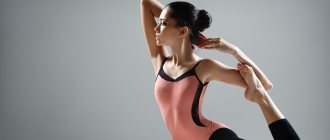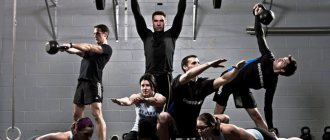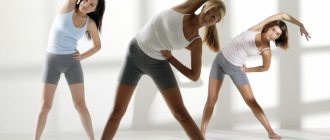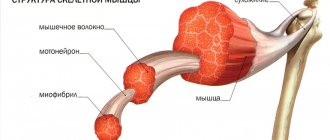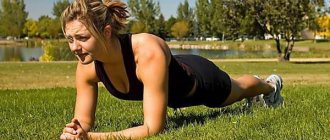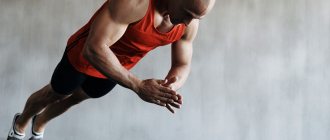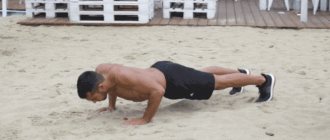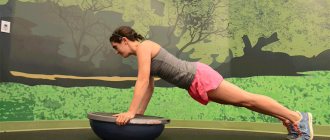Author: Petrenko Alexander - author of the site school-body.net Date:
2017-02-26
Views:
11,624
Rating:
5.0
| Medals articles >> |
Articles are loading...
When we get to the gym, we start with a short warm-up, which warms up the muscles and prepares them for work. Then everything develops according to the classic scenario. Having completed the exercise plan for the workout, we take the towel and, looking tired, head to the locker room. This approach to training is not entirely correct!
To speed up muscle growth and improve overall results, you need to stretch after training. How will this help in muscle development? What are the benefits of stretching? Let's consider these points in more detail.
What should beginners know?
Before you start training, you should familiarize yourself with the rules for conducting classes. It is especially useful for beginners to know them, because the main problem for beginning athletes is stretching before training. This approach not only does not help to gain weight and strengthen muscles, but also reduces the overall effectiveness of exercise.
The classic version of the training program consists of three stages in a certain sequence:
- Warm up. During the day, muscle fibers become tight to one degree or another, and joint mobility decreases. If you start exercising without proper preparation, you run the risk of ligament rupture, tendon inflammation, or more serious consequences. That's why you should spend a few minutes before class warming up the muscle, joint tissue and tendons. A thorough warm-up accelerates metabolic processes in the body and increases the plasticity of fibers, which ensures higher performance of the athlete and eliminates sprains and ruptures of ligaments during training.
- The second stage is, in fact, the main training program. The load it provides can be better absorbed by trained muscles. Due to the adhesion of myofibrils, the muscles are brought into working condition, and remain in it for several hours after strength training. You may have noticed that peak performance occurs approximately in the middle of the lesson. This means that all the exercises you performed at the beginning of the training were just preparation. Actually, this is why you need to warm up the muscles in order to reduce the time for accelerated metabolism and bringing the fibers into working condition.
- The final part is stretching the muscles after training. By completing the lesson correctly, you have the opportunity to receive a pleasant bonus: quickly regain strength and tone, increase flexibility, get rid of soreness, and avoid the discomfort and pain that beginners usually experience the next day after visiting the gym. But these are not all the benefits that you can experience if you stretch correctly.
What's the benefit?
Flexibility can be basic or special. Basic flexibility is a certain minimum that must be present for a person to live a comfortable life.
Let's take the hamstrings, how to check your level of flexibility? You need to lie on your back, legs together. Raise one leg straight up. In this case, the second leg, head, arms and the whole body should be pressed tightly to the floor. We lift only the tested leg! The norm is to raise it to 80-90 degrees, that is, this is the norm for a person who takes more or less care of himself.
Go ahead. If you squat and your heels rise, it means your ankle joint is not sprained. If you can't tie your shoelaces without bending your legs, then this is a more serious problem, more complex. Here, not only the back may not be stretched, but also the hips and iliac region.
Everyone needs basic stretching and flexibility. There is also a special stretching, but an ordinary person, in principle, has no need for it. It is mainly needed in certain sports. It is needed by dancers and ballerinas or swimmers who need to develop their shoulders. After all, if you just hammer and hammer them, without stretching them, then the moment will come when swimming will become quite problematic.
Exercises to increase muscle elasticity should be performed following certain rules. However, this applies to any type of training. It won’t take much time to complete them, and we hope the result will please you.
“Beautiful and Successful” will tell you more about the rules of stretching.
- Train in comfortable conditions. Choose a place and time so that no one will disturb you. Try to relax as much as possible and make sure that you only tense those muscle groups that a specific exercise is aimed at developing; try not to strain the rest.
- Give your muscles a chance to get used to the new state: stay in each pose for at least 30 seconds. It has been proven that statics make such exercises much more effective.
- The benefits of stretching ligaments and muscles will be greater if you do not do the exercises right away, “right off the bat.” Before you start exercising, warm up a little by doing a light warm-up: this will increase muscle blood flow and make it easier for your body to work.
- Do not strive to achieve maximum results in a short time. If you try too hard, your muscles signal this with pain. Remember: if pain occurs, you need to stop. Stretch the muscles gradually, carefully and carefully. You should feel a pulling sensation. Gradually the body will get used to the load, and the effort can be slightly increased. So, step by step, you will train your body. If you strive to do “everything at once,” the result will be not only tangible benefits from an exercise such as stretching; and you can also unwittingly cause harm to your muscles by being too zealous. For example, there is a high risk of getting a serious sprain.
- Train yourself to do stretching exercises both before training (after warming up, of course) and after it. Stretching after the main workout will help the muscles better “remember” the state of tone, as well as smoothly calm down, relieve tension and remove waste products.
- For the benefits of stretching exercises to be noticeable, you need to do them regularly. Flexibility and elasticity of muscles are properties that are quickly lost if the body does not receive appropriate constant loads. Even if you're not planning a workout today, take the time to do some simple stretching exercises at home: this will help keep your muscles toned, and you won't have to start all over again next time you workout.
Judaism preaches the unity of mind and body. At the same time, equal attention is paid to two areas - the development of the body and mind. A special role is given to flexibility, without which it is impossible to achieve good health and fortitude. It is believed that working on flexibility helps slow down aging, improve hormonal levels, activate brain function, and increase the effectiveness of exercise in the gym.
One of the main mistakes beginners make is stretching their muscles before starting a workout. With this approach, the muscles relax, the effectiveness of exercise is lost and the readiness of the fibers to accept heavy loads decreases. That is why such work should be moved to the end of the lesson.
But this is just the tip of the iceberg...
Why do you need muscle stretching after exercise?
The question is quite fair. From an anatomical point of view, stretching makes the tissues of tendons and joints, which act as attachments between muscles and bones, more pliable and flexible. In older people, as well as those who lead a sedentary lifestyle, such “fastenings” are more rigid. They limit a person’s mobility, and with strong tension, low-plastic ligaments can even tear. So, stretching allows the tendons to remain elastic so that a person can move freely and be able to handle the optimal load for himself.
Well, what about plasticity? What does it give to a person? Stretching exercises, as you already understand, increase this indicator. Thanks to plasticity, the human body gains more possibilities. Firstly, it will be easier for him to perceive power loads. Secondly, the likelihood of injury when performing complex exercises or unnatural movements will be reduced. And thirdly, your well-being and health will improve, and your musculoskeletal system will be strengthened.
Dynamic stretching
Represents swing and rotational movements.
Don't confuse dynamic stretching with ballistic stretching! Ballistic stretching uses jerking motions, while dynamic stretching uses gentle, gentle movements.
Start with light movements, gradually increasing the range of motion. Do not do this too harshly, otherwise you risk damaging your joints. Movements should be soft and smooth.
Exercises: swinging arms and legs, twisting the body.
Practical lessons
In theory, everything is quite clear. But how to combine stretching exercises to increase tissue plasticity, and how to do stretching correctly?
There are several rules for increasing the effectiveness of training using stretching that must be followed:
- Do stretching exercises after training (the reasons for this are written above).
- During the stretching process, slight pain is allowed, allowing you to understand that you are moving in the right direction.
- Avoid overexertion and pain. If sharp unpleasant sensations appear, it is better to modify the exercise or perform it with less intensity.
- At the maximum point of each exercise, you need to take a short pause (20-30 seconds), ensuring a sufficient level of load for the working muscles.
- When stretching the fibers of ligaments and tendon tissues, you need to move slowly to reduce the risk of tears and inflammation.
- The load can be increased gradually by increasing the number of repetitions.
- The target muscles should be relaxed during stretching so that there is no resistance to stretching.
- It is not necessary to use a special breathing system to increase the effectiveness of stretching. It’s better to breathe in a way that is comfortable for you, because this is not yoga.
- During stretching, train those areas that were subjected to greater stress + be sure to stretch your back and leg muscles.
- Do stretching in front of a large mirror. This technique will allow you to control the progress of the workout and monitor the correctness of the movements.
The benefits of stretching for girls
Although many men neglect stretching after training, women usually, on the contrary, really love this activity. Stretching after training for both girls and men is very beneficial for the whole body. Since every woman wants to have a beautiful and flexible body, such training is especially popular among women in gyms and sports clubs. Stretching has a whole range of effects on the body.
Thanks to stretching, a person can achieve the following results:
- relieves muscle tension;
- reduces stress on joints;
- increases body flexibility;
- increases the intensity of the workout;
- stretches muscle fibers, making them grow faster in the future;
- improves blood circulation.
The benefits of stretching before and after exercise are great. It has a complex effect on the body. Stretching should be done by every person, even those who do not exercise regularly.
Many women do stretching without physical activity. It can be performed even at home. Stretching does not imply the use of special devices and equipment. It is performed with your own weight, although for those who practice regularly, you can purchase special weights that will increase the intensity of the stretch.
Many women strive to lose excess weight. Exercise allows you to quickly burn fat deposits in the thighs, buttocks and abdomen, as it increases blood circulation, saturates the blood with oxygen, activates the thyroid gland and normalizes hormonal levels. Regular stretching exercises have a positive effect on increasing libido, allowing the body to look slimmer and younger.
Regular exercise allows women to get a beautiful and flexible body. Joints and ligaments become more elastic, muscles are tightened, as a result of which gait improves, posture becomes more even, and even the oval of the face is tightened.
Women who do strength training sometimes forget about the importance of stretching, however, it is extremely important for those who want their body to look beautiful and attractive. By increasing the impact on the abdomen, thighs and buttocks, they become more elastic and toned. Any woman will like a slender body, especially since stretching does not require a lot of time.
You can even practice two or three times a week for an hour, this time will be enough to achieve good results.
At first, there may be unpleasant sensations in the muscles; in addition, during stretching, the muscles are stretched and the person feels a slight pain. Such symptoms are normal and they gradually disappear as the body gets used to the stress. However, too strong unpleasant symptoms should alert you. They should be avoided and if they occur, you must either stop the activity altogether or reduce the intensity of the stretching effect.
Types of complexes
There are several types of post-workout stretching, which differ in the exercises included in the complex. For example, the classic version includes exercises to work various muscle groups throughout the body. Its duration is about 1 hour. If you create an individual complex, which includes selective exercises for the muscles involved most during the training, stretching will take only 10-20 minutes. At the same time, it will be almost as effective.
We offer an example of a video with an express complex for the correct completion of training for girls.
As for a more detailed version, during such a cool-down the main muscle groups are stretched:
Upper body (neck, chest, arms, back)
To work out the muscles in the chest area, you need to take the position as in the photo and bend your spine until slight discomfort appears. For the shoulders and trapezius muscles - the following exercise is to abduct the straight arm to the side. To increase the effect, you can turn your head in the same direction where the stretching hand rushes. For the triceps, you can perform fairly simple movements with a short towel. Grabbing the edges of the towel from behind, as shown in the photo, you need to stretch the muscles of the upper arm by pulling the second edge down. The latissimus muscles are stretched in a wide-grip stance, from which the spine is arched (see the same photo). The simplest warm-up for the neck after training is tilting your head from side to side at a moderate pace. The biceps are warmed up after training when performing the following exercise. Standing at the door, you need to grab the door frame and smoothly twist your hand around its axis, preventing pain from appearing.
Lower body
To stretch the inner thigh after training, a modified “butterfly” is suitable - an exercise in which you need to place your foot against the wall while sitting against the wall and bend your body forward. You can stretch your lower back by sitting on a bench or chair and, with your legs spread wide (as in the photo), lower your chest to your hips. You can increase the elasticity of the biceps muscle by bending the body while sitting on a bench with your leg extended forward (see photo). The outer part of the thigh is also worked while sitting against the wall. Having straightened one leg, we bring the other behind it and try to pull her knee as close to her chest as possible. Quadriceps work is carried out in a standing position, leaning against the wall. Throwing your leg back, you need to grab it in the ankle area with your hand and try to pull it up. The calves are stretched when performing the exercise while standing with your toes on a stand, lowering your heel to the floor as low as possible.
This could be a cool-down routine to perform after a grueling strength workout. But it is also suitable for those who want to properly stretch their joints and ligaments after fitness. As for jogging, slightly different exercises are suitable for them, allowing you to stretch the muscles most involved during running.
Muscle stretching exercises in the gym
The best list of exercises for stretching muscles after strength training in the gym.
Buttock, back and obliques
Buttocks, back, oblique muscles
Lie on your back, stretch out, bend your left leg at the knee and smoothly, without rushing, begin to pull it towards your right side. In the extreme, taut position, hold the bent leg at the knee for a few seconds , feel a slight tension in the muscles and ligaments. Perform this exercise in 2 sets of 3 repetitions on each leg.
Buttocks, back, oblique muscles
Remain lying on your back, straighten your right arm perpendicular to your body, begin to pull your leg bent at the knee with your left hand onto your right side and onto the floor, while watching your pelvis so that it does not completely roll over to the right side, otherwise this will have no effect. way to stretch the gluteal muscles . When performing the exercise, do not lift your head, shoulders and supporting arm from the floor.
Groin and hip adductors
Groin and adductor muscles of the thigh
Lying on your back, straighten your arms along your body, bend your knees, bring your feet together, relax.
in this relaxed state for 1 minute, under the influence of gravity your muscles will stretch, as you train, reduce the distance between the pelvis and the turned out feet, and also to enhance the stretching effect, smoothly and without fanaticism , press your hands on your hips.
Spine
Spine
Lie on your stomach, pull your arms up to your head, lean on your forearms, so that your torso is slightly bent in the spine, at the angle you need. In this bent position, relax, hold for 20 seconds, feel a light, pleasant load in your lower back . Repeat this exercise 3-4 times.
While in the same position, pull your forearms towards your chest and shoulders, straighten your arms at the elbow joint, your back should arch, you will feel tension in the pelvis and lower back, relax them.
Spine
As you train, increase the angle of deviation of the torso from the horizontal, as well as the time the relaxed pelvis and lower back are under load.
This exercise helps in preventing a healthy spine .
Hip flexors
While standing, lower the knee of your right leg to the floor, while the knee of your right leg should be pushed forward.
Hip flexors
Make sure that your right knee, shoulder, and hip joint are in line. Adjust the degree of tension in the front of your right thigh by moving your pelvis forward.
Do 5-10 swings for one leg.
Posterior thigh
To perform this exercise you will need a Swedish ladder . Raise your right leg to the required height, while the left leg, like the right, should be fully straightened at the knee.
Posterior thigh
Do 10-15 swings towards the foot of your right leg. Make sure that the left leg is fully straightened at the knee joint , and the direction of the knee should coincide with the direction of the foot. As you train, increase the height of the leg lift, as well as the amplitude of the swings.
A fairly common exercise when a person sits on the floor, with his legs straightened at the knees, and performs smoothly rhythmic bends of the torso towards the toes. You may mistakenly think that this exercise stretches the hamstrings , but in reality it is aimed at improving the flexibility of the spine.
Quadriceps and knees
Quadriceps and knees
Find support, rest your left hand on it so that your body is completely straight, bend your left leg at the knee, and with your right hand grab your left ankle and pull it up.
As you practice, you will learn to pull your heel towards your buttocks , but do not strive to develop extreme flexibility in this exercise, due to the fact that there is a high probability of stretching the knee tendon. Switch legs and repeat the exercise.
Keep in mind that beginners in this exercise often confuse the order of actions: the left ankle is pulled up with the left hand, and vice versa, the right ankle is pulled up with the right hand.
Quadriceps and knees
And this, in turn, has a destructive effect on the knee joint due to the unnatural bend.
To perform this exercise more safely, do the same thing only while lying down.
Spine, back, neck and shoulders
Spine, back, neck, shoulders
Find a chair or something similar, such as a bench with a back, sit sideways to the back. Holding your pelvis and legs, make a motionless turn with your torso , point your shoulders and head in the same direction, apply the necessary effort to the back of the chair for a stretching effect, stay in this position for a couple of seconds.
Sit on the other side and repeat this exercise. The increase in the amplitude of the stretching movement should occur smoothly and gradually.
Neck
Neck
Sit on a chair, straighten your back, look straight ahead.
In this position, tilt your chin down and turn your head first in one direction, then in the other, slightly helping with your hand to ensure the desired stretch of the neck.
Do 3-4 reps on each side.
Neck
Legs and lower back
Sit on the cards, with both hands press first on your right knee, then on your left knee, imagine as if you want to remove the weight from your knees .
In this simple way, you can achieve full amplitude bending of your knees, and this in turn will keep them healthy.
Legs and lower back
Squat down so that your buttocks touch the floor. Hold the lower position for 20 seconds and stand up.
Perform 2 sets of 2 reps. This exercise puts quite a lot of stress on the knee joint, so it is recommended that you first help yourself with your hands at the lowest point.
Shoulders and chest
To complete this exercise you will need a doorway, or something similar to it. Approach so that your socks are at a distance of 7-8 cm from the doorway and rest your bent arms against the wall or door frames, as shown in the figure.
Shoulders and chest
The optimal angle of flexion at the elbow joint is about 90-100 degrees , make sure that your shoulders are parallel to the floor. As you lean your body forward, you will experience a slight stretch in your shoulders and chest.
In order to progress in this exercise, you need to stand up each time a little further from the doorway , while your hands should remain in the same place, thus, when you bend forward, you will experience more and more tension in the shoulder girdle.
Do this exercise with caution to avoid straining your pectoral and shoulder muscles.
Achilles tendon
Achilles tendons
Find a step of the required height to perform the exercise in full amplitude. Place your right foot on the step and shift your body weight; only the front of your foot . the Achilles tendon stretch . Change your leg.
We need flexible Achilles tendons so that we can squat in regular shoes, with a normal heel, without the need to place weights or other objects under the heel.
Post-workout spinal stretch
Hang on the bar , grip shoulder-width apart, you should relax your lower body and feel your vertebrae straighten, fatigue leaving your lower back.
Spine
Do not jump off the bar abruptly, you may injure your spine.
Be sure to perform this exercise after heavy, compound exercises such as deadlifts and squats, and indeed after any other exercises that place significant compressive load on the spine.
If you want to stretch your spine at different angles, then simply raise your knees to waist and smoothly rotate your hips.
If your gym has equipment for hanging upside down , you can use it instead of hanging on the bar.
Spine
Find two pillows, lie on the floor and place them under your pelvis, while relaxing your lower back as much as possible, lie there for about 1 minute . When performing the exercise correctly, you will feel a release in the lumbar region.
When you finish doing this exercise, do not lift your torso , you can easily injure your spine, just roll onto your side and stand up.
Shoulders, arms and chest
Shoulders, arms and chest
Twists are an exercise for those who want to hold the barbell as low as possible on the trapezius during squats.
With both hands, take a stick or a towel, as shown in the figure, spread your legs shoulder-width apart, straight back, begin to raise your straightened arms at the elbows above your head and lower them behind your head as low as possible, this will count as one repetition .
Shoulders, arms and chest
As you train, reduce the distance between your hands, do three sets of 10-15 repetitions .
This list of exercises is a universal scheme for stretching after a workout.
Take your time to do all the exercises at once; first of all, stretch the muscles that you trained in the gym.
Stretching after running
Many athletes who prefer running to strength training neglect to stretch.
And this is one of their main mistakes. Stretching after running is no less important than the workout itself. For runners, ideally, you should first perform a preliminary warm-up, after which you can start jogging, completing the training with a set of exercises to increase the plasticity of ligaments and muscles. Professionals of this sport quite often have problems due to insufficient stretching. This is expressed not only in a tendency to injury, but also in a decrease in step width and a decrease in speed. By correctly finishing your run with stretching exercises that stretch the ligaments and tendons, you can make your quadriceps stronger and more resilient, the physical form of which directly affects the capabilities of runners.
Exercises that can be included in the express complex before and after running are suggested in the picture below.
In this article, we tried to explain in detail why stretching is needed and when it is better to start it - before or after training. In conclusion, I would like to say that after completing the main complex and cool-down exercises, you can hang on the horizontal bar for several minutes. This way you will not only consolidate the results obtained during the classes, but will also be able to relieve your spine. After this, you can calmly go to the locker room and, having changed clothes, go home in a good mood.
Ballistic stretch
The goal of this type of stretching is to increase your range of motion.
When performing a set of exercises related to ballistic stretching, you should do short bursts using inertia. These movements stretch the muscles and increase the range of motion.
Do not make too sudden movements - this may lead to injury.
Exercises: touching the tips of the toes with your fingers from a standing and sitting position, swinging your legs, mill.
Stretching is a law of nature
We must always remember that nature acts according to its own laws. The longer you train your muscles, the more stiff your joints become. Their amplitude will gradually decrease. No matter how strange it may sound, it is in your own interests. Thanks to this enslavement, the skeleton becomes stronger.
But stretching exercises shouldn't become an obsession. Remember that excessive stretching and pursuit of flexibility can result in serious injury. Plus, stretching muscles after training affects not only joints but also muscle ligaments, which also stretch over time. As you may have guessed, it may happen that the muscle ligaments one day do not return to their previous size:
- there is a slow change in muscle shape
- weakening of skeletal nodes
- the middle part of the muscles becomes compressed
- the ends stretch out quite disproportionately
What do we do?
Stretching your muscles after a workout is highly recommended for everyone!
Let's look at a classic exercise for stretching the hamstrings - forward bends. When performing this exercise, the athlete should reach with his fingertips towards the floor without bending his knees. Forcing the exercise out of ignorance leads to a shift of the load from the legs to the lower back. Due to anatomical features, the muscles of the lower back cease to be involved.
Almost the entire load goes to the spinal ligaments. If you perform this exercise too often, the ligaments will definitely stretch and never return to their previous size. This will cause the vertebrae to move freely relative to each other. This development of the scenario is extremely undesirable - in case of overload, you can injure your lower back and pinch nerve endings.
Carefully! Barrier stretching!
This exercise is also familiar to many. You are sitting on the floor. One leg is straight in front of you, the other leg is bent at the knee and pressed to the floor with the inner thigh. You lean forward and try to reach with your fingertips the toe of the leg stretched out in front of you. Sometimes you can see an advanced version of this exercise: You are standing.
One leg is bent at the knee, which rests on a bench or chair. From this position, you should reach the floor with your fingers, but you cannot bend the other leg. Another type of stretching is also performed: you sit on the floor, both legs are straightened and spread to the sides. You can bend either towards the floor or alternately towards both legs with your shoulders turned.
All of the above types of stretching (as well as standing bends) greatly overload the spine. The lumbar region is stretched quite noticeably. But the hamstrings and hip adductors do not receive proper stretching. The outer sectors of the spinal discs are compressed. Dangerous tension occurs in the joint capsules.
What to do after stretching
After each exercise you need to smoothly return to normal. Then you can safely go change clothes.
Horizontal bar! Hang on it as long as you can. This is a great addition to the whole package you've made. Plus unloading of the spine.
Remember - no matter what stretch you initially have, you can make it bigger. We don't promise that you will do the splits, but you will definitely become more flexible. And flexibility is the health of muscles and joints, grace and beauty.
Bodymaster.ru recommends Training Plans:
Stretching prevents stiffness. Over the years of training without high-quality regular stretching, the athlete’s muscles “remember” their shortened length and get used to it.
Muscle contraction and relaxation are two sides of the same process. As much as it can stretch, it can shrink further. If the muscle has not been stretched, it will contract less well, which will cause stagnation in strength results. We offer a simple set of exercises in a video program.
Also, stretching exercises prevent various injuries. According to statistics, athletes who regularly stretch are half as likely to suffer sprain-related injuries. If these professional guys take stretching responsibly, isn't it time for you to think about it too?
pros
- Improves athletic performance. Regular post-workout stretching is known to increase the upper limit of your lifting weights by about 10%.
- Accelerates muscle recovery. Stretching literally means stretching the myelin fibers of muscle tissue. If this step is neglected, the process takes considerable time. By artificially stretching your muscles, you speed up the process of rest and recovery.
- Prevention of muscle stiffness. Muscles that grow as a result of training somehow “remember” their compressed position and adapt to it. As a result of this, over time, their contraction length decreases, which causes stiffness in movements. Stretching helps avoid this effect.
- Prevention of injuries. Performing exercises for a long period and not doing stretching after them is tantamount to driving a sports car for a long time without changing the oil - sooner or later something will break down. Take care of your health!
Interesting fact. The key rule of any stretching is static. Stretch the muscles in a fixed, “frozen” position, without any vibrations or jerks. Get into a pose to stretch the areas of your body you need. Slowly work the muscle to the point where you feel slight pain. Freeze in this position for about a minute.
PNF stretching
PNF – proprioceptive neuromuscular facilitation. The essence of this method is to relax the target muscle group after tension. It is the most effective and fastest option for increasing static-passive flexibility.
It is a combination of passive stretching and isometric stretching. First, the muscles undergo passive stretching, which is then replaced by a phase of isometric contraction in a stretched position with resistance, and then passive stretching with increased amplitude comes into play again.
The effectiveness of this technique will increase if you have a partner to help you perform the exercises. He will create isometric resistance and then perform a passive movement with an increased range of motion.
The muscles being stretched should relax for 20 seconds before the next stretch.
Types of PNF stretches
Contraction-relaxation
At the beginning of the exercise, after passive stretching, you should contract the muscle isometrically for 7–15 seconds. Then let it rest for a couple of seconds, then immediately repeat the passive stretch, but with more force. The final stretch should last 10–15 seconds.
It is the safest type of PNF stretching.
Contraction-relaxation-contraction
The first part of the exercise repeats the contraction-relaxation principle: an isometric contraction for 7-15 seconds and a short rest. While resting the muscle being stretched, you need to isometrically contract the antagonist of the target muscle for 7 to 15 seconds. Then let your muscles rest for 20 seconds.
Contraction-relaxation-maximum
This technique is recommended for use if you feel like an experienced athlete who has excellent control over the muscle reflexes of his body. Otherwise, you risk injury.
The first part is similar to the contraction-relaxation technique, but the final stage of the exercise uses dynamic or ballistic stretching.
Common mistakes when doing stretching
The muscles are not yet ready to stretch, because they have not yet warmed up. During the process of forced stretching, the risk of injury increases.
- Lack of rest between sets.
It happens that the muscle has not yet recovered from the previous load, and it is loaded again. You should not do this, because it can lead to muscle fatigue.
Don't overdo the stretching. Don't forget that you want to improve your muscle elasticity, not do another hard workout.
- Incorrect sequence of exercises.
If you mix up the sequence of actions, the muscles will not get the desired effect from the exercises. In addition, due to rash actions, you can easily get injured.
Passive stretching
The point of this type of stretching is that you stretch the muscles using your hands, aids, or a partner. For example, lift your leg up and fix the position with your hands.
The splits are also one of the passive stretching exercises. The floor acts as an auxiliary means of promoting muscle stretching.
Passive stretching is ideal for rehabilitating an injured muscle. Excellent relaxation after strength training, as it helps reduce fatigue and reduce muscle pain after exercise.
Isometric stretching
Another type of stretching, the essence of which is to use counteraction while stretching the muscles. You can include everything that can help you in your work: hands, floor, walls, partner. You must create resistance to the muscle being stretched. This method is much more effective than active and passive stretching separately.
For example, you can bend one leg and hold your foot with your hands while trying to straighten your leg.
Another example of isometric stretching is the wall push exercise. Stand against a wall and try as hard as you can to move it. It is clear that you will not succeed, but you will perfectly stretch the muscles of your body, providing them with blood flow.
An equally wonderful exercise is moving the doorway apart, which helps stretch the spine and improve the overall health of the back.
Isometric stretching is not recommended for children and adolescents. The body at such a young age continues to grow and has great flexibility. Therefore, exercise can lead to undesirable consequences: injuries to tendons and connective tissues.
Avoid performing isometric stretching exercises several times a day. There should be a gap of approximately 36 hours between sessions.
Proper execution of isometric stretching is achieved through the following simple steps.
- Take the starting position as for passive stretching.
- Using resistance, tense the muscle you want to stretch for 7 to 15 seconds.
- Relax the muscle for at least 20 seconds.
Effective stretching exercises
Here are some exercises you can do to effectively stretch after your workout.
For hips
- An elementary but effective exercise - with your right hand we grab the foot of the same name and pull it towards the buttock. We stretch the muscles until we experience a characteristic feeling of tension. We repeat a similar movement for the left limbs.
- We rest our hands on the surface of the wall. We take a step back and bend our back well. In this simple way the back surface of the thighs is worked out. Additionally, the lumbar region is involved.
- We sit on the floor or gymnastic mat. We stretch our legs to the sides. Let's do some good old bending. They work great on the inner thighs.
For the lower back
- We sit on the floor, stretch our legs forward. The main task is to stretch forward so that your hands touch your toes. At the same time, it is important not to bend the limbs - they should be completely straightened. There is a little trick that makes the exercise much easier - pull in your stomach!
- We lie down on our backs. We throw our legs over our heads so that our toes touch the surface of the floor.
For the chest
- We stand in the doorway. We rest our hands on the doorposts. It’s as if we’re falling forward with our whole body. We fix ourselves in a maximum forward bend for 1 minute. This exercise is a great stretch for the pectoral muscles.
- If there is no suitable door frame nearby, this exercise can be easily performed using a special expander (exercises with an elastic band).
